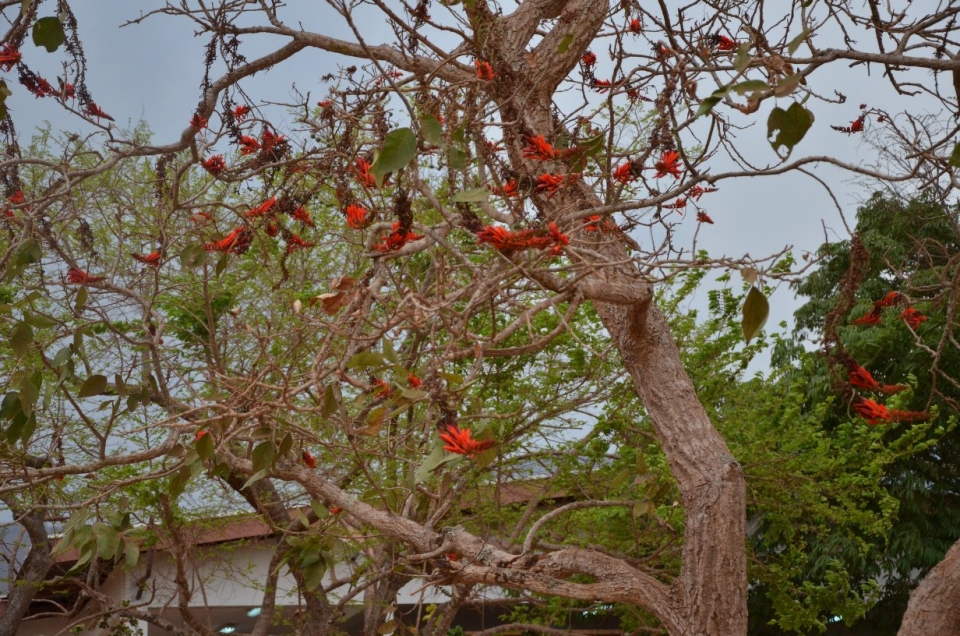Erythrina senegalensis

|
|
Erythrina senegalensis Common Names: Senegal Coral Tree, Parrot Tree, Coral
Tree, Red Bean Tree Scientific
Classification Kingdom: Plantae Clade: Tracheophytes Clade: Angiosperms Clade: Eudicots Clade: Rosids Order: Fabales Family: Fabaceae Subfamily: Faboideae Genus: Erythrina Species: E. senegalensis Binomial Name: Erythrina senegalensis DC. Synonyms: Chirocalyx latifolius (Schumach. & Thonn.) Walp., Corallodendron
senegalense (DC.)
Kuntze, Erythrina guineensis G.Don, Erythrina latifolia Schumach. & Thonn., Macrocymbium vogelii Walp. Morphological Description Erythrina senegalensis is a deciduous tree, typically 6–20 m tall, with a spreading
crown. Key features include: · Stems: Spiny, greyish-brown bark, thorny branches · Leaves: Trifoliate, leaflets ovate, 5–15 cm long, green · Flowers: Bright red, 3–5 cm long, in dense racemes, pollinated by
birds · Seeds: Bright red, 1–1.5 cm, in curved pods (5–15 cm) Distribution and Habitat Erythrina senegalensis thrives in: · Native Range: West Africa (Senegal to Cameroon, Sudan) · Habitat: Wooded savannas, gallery forests, termite mounds; 0–1,200 m
altitude · Soil: Well-drained, sandy-loam, pH 5.5–7 · Climate: Tropical, semi-arid, rainfall 600–1,500 mm It tolerates drought and
is common in disturbed areas (PROTA, 2019). Ethnopharmacology Erythrina senegalensis plays a pivotal role in West African
traditional medicine, being utilized for treating a variety of ailments,
including malaria, jaundice, infections, gastrointestinal disorders (such as
gastric ulcers, diarrhea, and constipation), amenorrhea, dysmenorrhea,
sterility, onchocerciasis, and various types of pain (chest, back, abdominal,
headaches, and general body weakness). The plant is also reputed for its
wound-healing and contraceptive properties: · Anti-inflammatory/Analgesic: Bark decoction in Mali; reduces pain in
rats (50% at 200 mg/kg) (Saidu et al., 2000). · Antimicrobial: Leaf extract in Nigeria; active against S. aureus (MIC 50 µg/mL) (Doughari, 2010). · Antimalarial: Stem bark in Cameroon; antiplasmodial in mice (40% at 300
mg/kg) (Saidu et al., 2000). · Wound Healing: Leaf paste in Senegal; promotes healing (Togola et al.,
2008). · Antioxidant: Leaf extract in Burkina Faso; scavenges DPPH (IC₅₀ 30 µg/mL)
(Fofana et al., 2022). · Respiratory Conditions: Root decoction in Mali; treats coughs
traditionally (Togola et al., 2005). · Gastrointestinal: Bark tea in Nigeria; reduces diarrhea (50%
at 400 mg/kg) (Atsamo et al., 2011). · Sedative/Epilepsy: Bark infusion in Ghana; anticonvulsant in
rats (60% at 200 mg/kg) (Musa et al., 2018). ⚠ Toxicity Profile: Alkaloids toxic at >500 mg/kg (LD₅₀ 774 mg/kg
in mice); seeds cause vomiting if ingested raw (Udem et al., 2010). Additional Information · Cultural Significance: Red seeds used in jewelry, rituals in
Senegal. · Ecological Role: Nitrogen-fixer, enhances soil fertility in
savannas (PROTA, 2019). · Other Uses: Wood for fuel, bark chewed as aphrodisiac in Nigeria (Togola
et al., 2008). References
External Links More Pictures |
|
| Compounds of Erythrina senegalensis | |
| References | 2. Murtala Muhammad, Etal. (2023). Phytochemical analysis of Nigerian medicinal plants.
NMPP-DB Project, Department of Biochemistry, Kano University of Science and
Technology, Wudil |